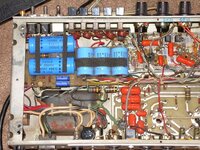Wizard of Ozz
Well-known member
It could very well be a thing, I’ve just never once heard the term “amp break in” or anyone say I’m gonna wait for a new amp to wear in till two hours ago in this thread. Someone now needs to buy a new amp, record a di track, record a clip brand new, leave the amp on for a few days strait then do another di clip to get to the bottom of this lol
Electronic components do change over time.
Caps drift, resistors no longer hold the same value off resistance, or fail, etc etc... but that's over a long period of time. Not 1 or 2 years.
The OG Mark 2C+ amps are 40 years old. Even after a new electro cap job, you can hear a difference. But they still sound similar. I have 60 year old Marshalls which also prove this as well.
The point that amps will "break-in" or change sound over a period of time... is true... but this period of time can be 20 - 30 years or more.
I think the issue is the modern build methods, parts, solder, wire, transformers, etc etc have more to do with the end product than anything else.
Randall Smith said the same himself before selling Mesa. If reissuing a Mark IIC+ was so easy... RS would have done it years ago. He stated himself it can't be done for these same reasons.
Also a lot of the amp hiss squeal noise people are complaining of is due to the shit tubes they ship with. Take out the those shit tubes, smash them with a hammer and replace with some quality, tested NOS glass.
Short version: If an amp sounds like ass or not how it should... I sell it or return it. It don't stick it in the closet to marinade for 30 years and hope the sound will improve.
Last edited:




